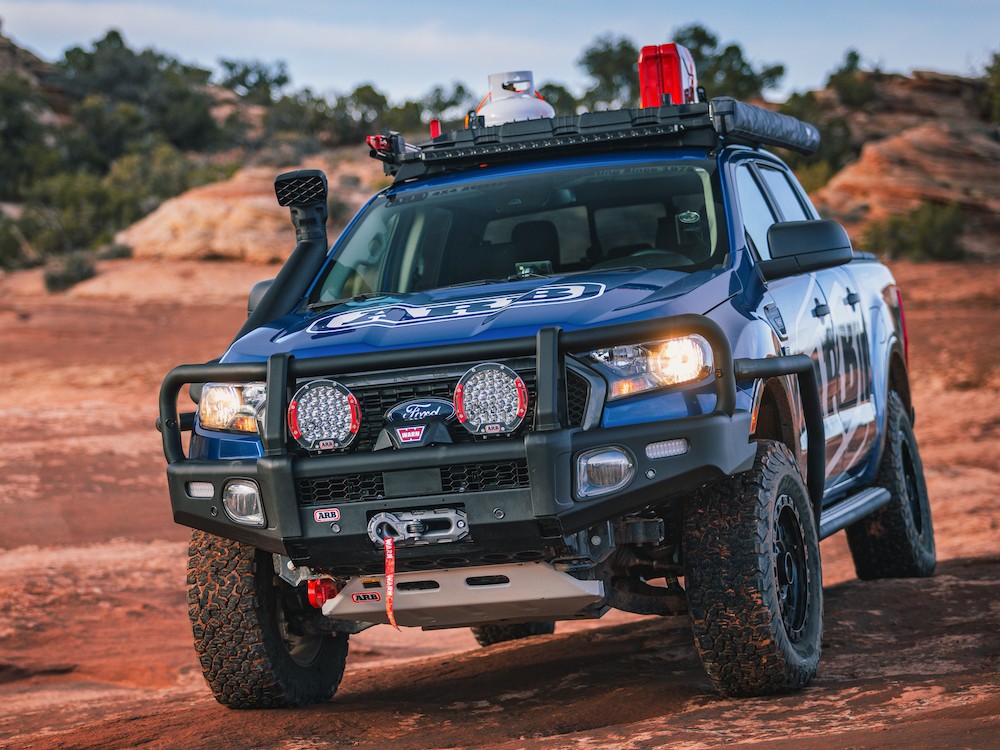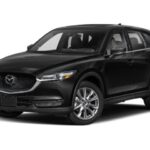In the realm of overlanding, the quest for the perfect vehicle is often as much a part of the adventure as the destinations themselves. While declaring a single “best” overlanding vehicle remains elusive – heavily dependent on personal preferences, budget constraints, and specific travel needs – we, as automotive experts at cardiagxpert.com, understand the critical factors that elevate a vehicle from merely capable to truly exceptional for off-grid exploration. These factors include payload capacity, fuel efficiency, power delivery, vehicle dimensions, handling characteristics, off-road prowess, reliability, and overall affordability.
For the first time, we’re stepping beyond broad considerations to spotlight specific models that stand out in various categories. Today, we’re diving deep into the segment of mid-size pickup trucks, a sweet spot for many overlanders due to their blend of capability and maneuverability.
Top Mid-Size Pickup Trucks for Overlanding
1. Ford Ranger (Fifth Generation, 2019-Present)
Prepare to be surprised, perhaps even challenge your loyalty to other brands, as our top pick for mid-size overlanding trucks is the fifth-generation Ford Ranger. While it may raise eyebrows among some dedicated Tacoma enthusiasts, the Ranger secures its position through a compelling combination of features.
Payload capacity is paramount for overlanding, where gear and supplies accumulate rapidly. The Ranger boasts a payload range of 1,609 to 1,905 pounds, significantly outperforming key competitors in the segment. Let’s compare:
- Toyota Tacoma (Third Generation): 1,050 to 1,685 lbs (TRD Pro: 1,135 lbs)
- Chevrolet Colorado (Second Generation): 1,270 to 1,560 lbs
- Nissan Frontier: 1,296 to 1,708 lbs
- Jeep Gladiator: 1,080 to 1,200 lbs
- Honda Ridgeline: 1,509 to 1,583 lbs
Notably, the Honda Ridgeline, often considered less of a traditional truck, even surpasses the Tacoma TRD Pro in payload. This highlights the Ranger’s impressive load-carrying capability within its class.
Beyond payload, the Ranger distinguishes itself with an available electronic locking rear differential (within the FX4 package), a robust, fully boxed frame (a structural advantage over the Tacoma’s partially boxed frame), and a relatively compact footprint. Its maneuverability in tight off-road scenarios is a distinct asset, especially on narrow trails.
Under the hood, the Ranger’s 2.3-liter EcoBoost turbocharged four-cylinder engine delivers a punchy 270 horsepower and 310 lb-ft of torque. This powerplant surpasses the Tacoma’s 3.5-liter V6 in torque (265 lb-ft), while offering comparable horsepower (278 hp). Coupled with a standard 10-speed automatic transmission (compared to Tacoma’s six-speed), the Ranger provides responsive power delivery and efficient highway cruising.
While the Tacoma has long been favored for its aftermarket support, the Ranger benefits from substantial global support, given its international presence since 2011. Major brands like ARB offer a wide array of overlanding accessories specifically designed for the Ranger, ensuring ample customization options.
In summary, the fifth-generation Ford Ranger emerges as a top contender in the mid-size truck segment for overlanding. Before settling on a Tacoma, experiencing the Ranger firsthand is highly recommended. Personal experiences building and driving a Ranger confirm its excellence and suitability for overlanding adventures.
2. Chevrolet Colorado (Second Generation, 2014-2022)
Securing the second spot is the second-generation Chevrolet Colorado. With the third generation now emerging, the second-gen Colorado remains a compelling choice, especially for those seeking value and proven performance.
A standout feature of the second-gen Colorado is its powertrain diversity and cab/bed configurations. The four-door, long-bed variant is particularly appealing, offering a spacious interior coupled with a practical six-foot bed. This configuration bridges the gap between mid-size maneuverability and full-size storage capacity, a valuable asset for extended overlanding trips.
While locking differentials are not standard on all Colorado trims, the ZR2 variant elevates its off-road capability with front and rear lockers. It’s worth noting that the ZR2 configuration is available in both four-door five-foot bed and extended cab six-foot bed options.
Powertrain options for the second-gen Colorado include a notable diesel engine offering. While the allure of diesel torque is undeniable, real-world experience suggests that the diesel variant may not be the most economically sound choice for overlanding. Despite increased torque, towing capacity remains comparable to gasoline versions.
Diesel Colorados come with a significant price premium and do not consistently deliver fuel economy gains sufficient to offset the initial cost and higher maintenance demands, including more frequent and expensive servicing and pricier diesel fuel. For overlanding purposes, the 3.6-liter V6 gasoline engine is a more pragmatic choice. Producing 308 horsepower and 275 lb-ft of torque, paired with an eight-speed automatic transmission, this V6 offers reliable and robust performance.
Aftermarket support for the Colorado, while not as extensive as for the Tacoma, is still substantial. Reputable brands like CBI offer robust armor solutions, enabling enthusiasts to build highly capable overlanding Colorados.
3. Jeep Gladiator JT (Second Generation, 2018-Present)
The Jeep Gladiator earns its place on this list by virtue of its exceptional off-road capability, even if it compromises somewhat on interior space and on-road refinement. Sharing components with the Wrangler JL, the Gladiator benefits from an expansive aftermarket parts ecosystem, making customization straightforward.
For overlanding builds, the Pentastar V6 engine paired with the eight-speed automatic transmission remains a solid choice. This combination delivers 285 horsepower and 260 lb-ft of torque, providing adequate power for both on and off-road driving.
The Gladiator’s defining features include its solid front axle, disconnectable sway bar, and the option for soft or removable hard tops. While not excelling in every area within the mid-size segment, the Gladiator stands out as a uniquely capable and enjoyable vehicle, particularly for those prioritizing challenging off-road terrain. Its inherent “fun factor” and distinctive character contribute significantly to its appeal among overlanders.
What Defines a Great Overlanding Truck?
Beyond specific models, understanding the core attributes of an ideal overlanding truck is crucial. The criteria for an overlanding vehicle diverge significantly from typical commuter vehicle considerations. While fuel efficiency and daily driving comfort are always relevant, overlanding demands a vehicle that is exceptionally versatile, capable of handling diverse conditions, and self-sufficient for extended periods away from conventional infrastructure.
Payload Capacity:
Payload capacity reigns supreme when selecting an overlanding truck. The ability to carry substantial weight – including camping gear, water, fuel, recovery equipment, and personal supplies – is non-negotiable. Surprisingly, payload capacities can vary widely even within the same vehicle class. Thoroughly research and understand the payload ratings for your chosen truck configuration to ensure it aligns with your overlanding needs.
Fuel Economy and Power Output:
Balancing fuel economy and power is essential for overlanding. While historically these were often trade-offs, modern engines are achieving both efficiency and robust power delivery. Prioritize a truck that offers a reasonable fuel range on a single tank, considering the vast distances often covered in overlanding expeditions. Even if ultimate fuel efficiency isn’t achievable, ensure provisions for carrying extra fuel through jerry cans or auxiliary fuel tanks are feasible.
Size and Footprint:
Vehicle size is a nuanced consideration. While maneuverability on tight trails is crucial, don’t overly fixate on minimizing width. Many overlanders are successfully transitioning to full-size trucks, demonstrating that skilled driving and careful navigation can overcome size constraints. Consider the balance between interior space, cargo capacity, and external dimensions in relation to the types of trails you anticipate encountering.
Driveability:
Overlanding trucks must be enjoyable to drive both on and off-road. Long stretches of highway driving between trails are common, demanding a vehicle that is comfortable and well-mannered on pavement. Independent front suspension (IFS) generally offers superior on-road comfort compared to solid front axles, although solid axles can provide enhanced off-road articulation and durability. Tire choice also significantly impacts driveability. All-terrain (A/T) tires are often a more versatile choice for overlanding, balancing on-road refinement with off-road traction, compared to more aggressive mud-terrain (M/T) tires that can compromise highway comfort.
Capability:
While ultimate off-road capability is desirable, prioritize practical and realistic capability for your intended adventures. Overlanding is often more about journeying through varied terrain than extreme rock crawling. Essential capability features include adequate ground clearance, four-wheel drive (4WD) or all-wheel drive (AWD) with low range, and traction aids like locking differentials or electronic traction control. Remember that driver skill and well-chosen driving lines often outweigh minor differences in vehicle capability. Investing in overlanding driving training can be more beneficial than solely focusing on extensive vehicle modifications.
Reliability:
Reliability is paramount for overlanding, where breakdowns in remote locations can have significant consequences. Choose a truck with a proven track record of reliability and consider parts availability in your intended travel regions. While imported or niche vehicles may have unique appeal, mainstream models with established parts networks often offer greater peace of mind. Regardless of vehicle choice, basic mechanical knowledge and the ability to perform trailside repairs are invaluable assets for any overlander.
Affordability:
Budgetary considerations are a fundamental aspect of overlanding truck selection. Factor in not only the purchase price but also the costs of necessary modifications, ongoing maintenance, potential repairs, and fuel expenses. Overlanding can be enjoyed across a wide range of budgets, and newer vehicles (post-2006) generally offer improved safety features, build quality, and parts availability. Ultimately, choose a truck that aligns with your financial resources and enables you to embark on your overlanding journeys responsibly.
Conclusion:
Selecting the best mid-size truck for overlanding is a personalized decision, guided by your specific needs and priorities. The Ford Ranger, Chevrolet Colorado, and Jeep Gladiator each present compelling strengths in this category. By carefully evaluating payload, fuel efficiency, size, driveability, capability, reliability, and affordability, you can confidently choose a mid-size truck that will serve as a reliable and capable partner for your overlanding adventures. Remember, the journey is the destination, and the right truck is your key to unlocking unforgettable experiences.

